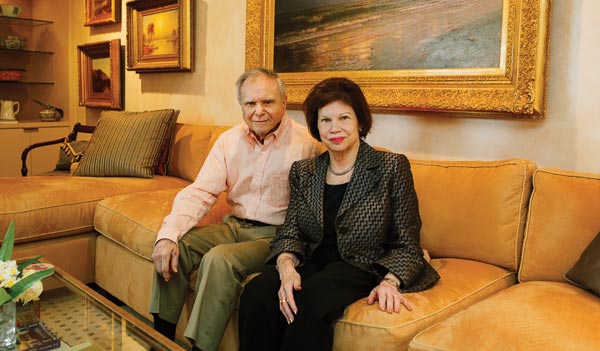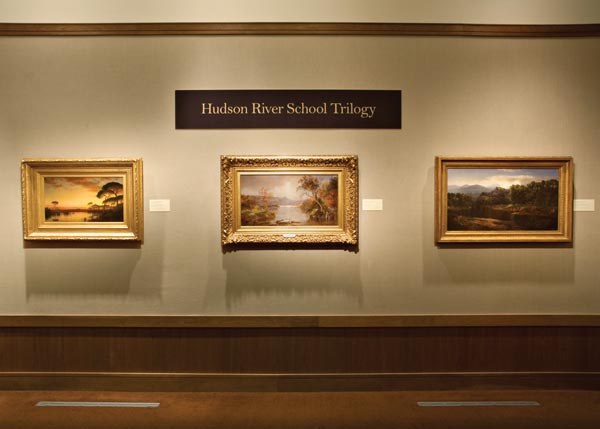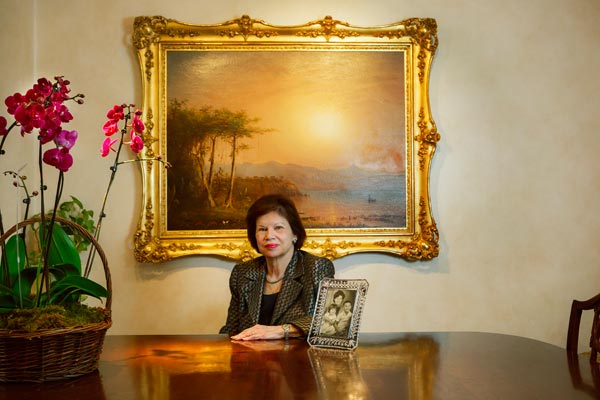Art: A Love Affair
In the fall of 1984, Maryann Kallison Friedman ’55 and her husband, Al, attended a lecture given by art historian, author, and former Vassar adjunct professor of American art Ella Foshay at what was then the Vassar College Art Gallery. The lecture was titled “All Seasons and Every Light.” There they saw anew—through Foshay’s lens—Vassar’s collection of small canvases by Hudson River School artists. These beautiful paintings, featuring bucolic views of the Hudson River, had been purchased by Vassar College in 1861 from one of its founding trustees, Reverend Elias Lyman Magoon. Inspired by the beauty of the Magoon Collection, Al proclaimed to Maryann that they “should change course and begin collecting Hudson River School paintings.” Maryann hesitated, but soon realized it was the right path for them.

Over the next three years, the Friedmans attended lectures, classes, auctions, galleries, and exhibitions highlighting the works of the famed mid-19th century landscape artists. They read every book and catalogue published on the subject. Then they bought their first painting, Mill Brook Near Shelburne, NH, by William Louis Sonntag, in March 1986. They did so without consulting an expert—a process they remained committed to throughout their years of collecting.
Prior to that time, the Friedmans had purchased a few paintings and works on paper during their travels, but they are quick to point out that they were not informed collectors. Foshay’s lecture at Vassar changed everything—what they collected, the way they viewed a canvas, and how they lived with their art. Foshay had emphasized the genius of mid-19th century American artists—their ability to capture serene landscapes and spectacular light in all seasons. Not only did the Friedmans come away from the lecture with a renewed appreciation of beautiful works of art, but they also found themselves excited about researching their new passion—the art of the Hudson River School.
With every painting they purchased, their criteria remained constant: refined composition and brilliant color. They never purchased a work purely based on the reputation of the artist. Certainly the artist played a major role, but as Al says, “You can have a really beautiful painting by a lesser known artist and a really bad painting by one of the greats!”

As they wrote in their 2007 catalogue, A Focused Collection: The Hudson River School: “All our paintings have common features: limpid, quiescent views of serene waters, distant mountains, and appealing foliage. Nothing is seen that appears turbulent or jarring. The images invite the viewer to enter the works and experience quietude, relaxation, and repose. The underlying theme is varied exposure to an unspoiled nature, in which humanity has only a limited presence or is entirely unseen.”
Over the next 20 years, they actively collected works in Philadelphia, Boston, and New York. They met with dealers, gallery owners, and attended art auctions. They discovered the seasons they appreciated most—fall and spring—and they continued to train their eye.
“As you live with art, you get a renewed appreciation for details that emerge, depending on the light or the angle. Details reveal themselves over many years and always delight the viewer,” says Maryann. While it’s impossible to have a favorite painting, one work that offers perpetual tranquility for Maryann is Sailing off the New England Coast, by Alfred Thompson Bricher.
“You get a feeling about a painting,” adds Al. “You move it around, change the lighting. Then, and only then, do you know you can truly live with it. When you rise in the morning, you have to love what you see.”
They fondly remember coming upon the painting Tropical Landscape by the then–relatively unknown artist Norton Bush. Maryann felt immediately drawn to the color and palette. She recognized the composition as a stunning represen-tation; it had to come home with them. In recent years, Bush has become much more recognized and appreciated for his work, which often is compared to that of Frederic Edwin Church.
Time, attention to detail, knowledge, good instincts, and, most importantly, a shared love of the artwork, have come together to help the Friedmans build an exceptional collection of 19th-century American art. They wrote in the 2007 catalogue: “We have remained focused on our chosen field. A sense
of growing confidence and expertise led us, since the late 1980s, to acquire, among others, major ‘autumnal’ works
by Jasper Francis Cropsey, two marsh scenes by Martin Johnson Heade (Northern Marsh: Sunset, Florida Marsh: Dawn), and exquisite luminous work by William Stanley Haseltine (Sunset Glow, Roman Campagna), a classic, large seascape by William Trost Richards, and three works by Sanford Robinson Gifford.”
Over the course of their collecting, Maryann’s close involvement with the Frances Lehman Loeb Art Center led the couple to assemble 11 of their paintings for the Art Center’s exhibition A Hudson River Trilogy in the fall of 2007. That trilogy showcased the Art Center’s holdings, the Friedman’s paintings, and a number of exquisite drawings from the Dia Art Foundation. The show broke attendance records. Adding to the importance of the exhibition was Ella Foshay, who accepted the Friedmans’ invitation to give a lecture in conjunction with the show a full 23 years after having first inspired them.

Foshay recalls the surprise call from Al, saying, “I was honored to be asked to view their impressive collection of American Art and give the lecture at Vassar. I had no idea I made such an impact on Maryann and Al so many years ago. They spoke about me affecting their lives—this lovely couple made a difference in all our lives! Delivering the lecture remains one of the most spectacular days of my life.”
Recognizing the Art Center’s commit-ment to a teaching collection for Vassar students and the community, it is the Friedmans’ intention that their Hudson River School collection eventually join the Art Center’s Magoon collection. “We want others to learn from, and be inspired by, these incredibly gifted artists that have brought us so much joy,” says Maryann. “In addition, we are committed to creating a conservation and travel fund, allowing our paintings to travel to other art institutions around the country.”
James Mundy, the Anne Hendricks Bass Director of the Frances Lehman Loeb Art Center and a member of the class of 1974, has known and worked with the Friedmans for over 20 years. “It is a pleasure to work with such passionate and committed collectors as the Friedmans. The quality of their collection shows their combined love and erudition. They are excellent role models for others who would wish to collect in any field—they went about it the right way.”
For the Friedmans, collecting remains “serious fun.” As Al says, “Some couples are driven apart through their collecting; we are driven together.”
As the magazine was going to press, we learned the very sad news of Al Friedman’s passing. We decided to continue with the publication of this piece, now in tribute to Al Friedman.